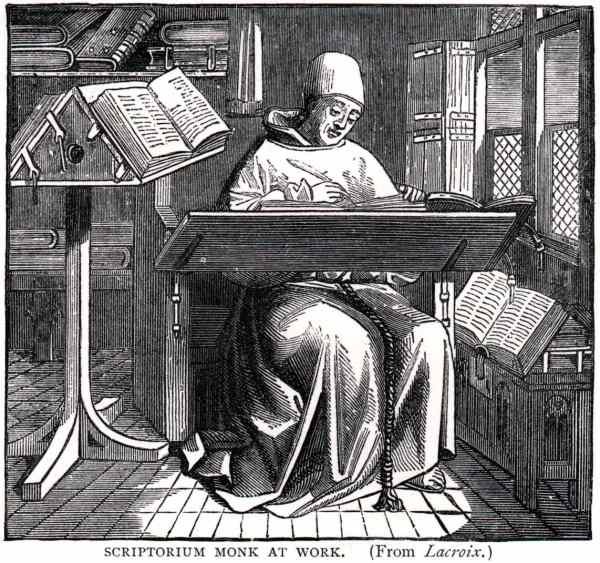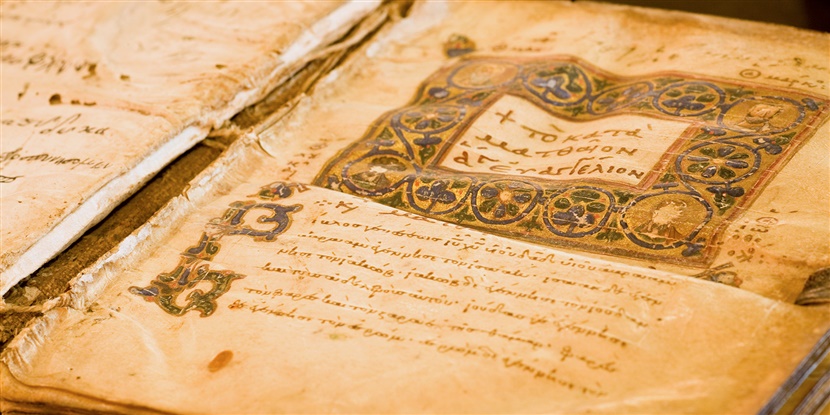Anita Ravi
BHP Expert, University of California, Berkeley, USA
History is a text-based discipline. At its core, the task of sorting through historical materials involves dissecting and interpreting how people in the past have related their experiences in writing. At times, we might incorporate into historical analyses nontextual sources—such as maps, artwork, and photography. But to do history well, we must be able to read and interpret text well. This can be a struggle if students enter your classroom reading and comprehending at levels other than you might expect.

Scriptorium monk at work. A monk copies a text from a large book on his writing-table. Public Domain
How to Approach Reading Difficult Text in History
As a history teacher, you know that any text written before, say, 1930, will be difficult for students. The author’s word choice and syntax might be foreign to students, and the way in which the writer makes a point is probably unfamiliar as well. Language, like any other human-created system, changes over time. If you approach historical text as an exercise in translation to modern English—for ALL students—you reframe the task of reading and interpreting history as an active process of meaning-making, thus emphasizing the task itself, and not the difficulty of it. But how exactly can you scaffold students to engage with and understand complex text? Here are two approaches to help students get ready to read complex historical texts.
Understand How Text Structure Relates to the Type of Source
In history, we tend to classify texts as primary sources or secondary sources. However, within each of these two categories, there is vast variation in the structure, purpose, content, and complexity of sources. A letter is perhaps the “simplest” form of historical text: there is an identified author writing to one or more people; it’s narrative in form; and it generally describes feelings and experiences of the author. Although letters often make a claim, the ways in which that claim is supported can be identified somewhat easily. In contrast, a public document—such as a treaty—is much more complex. Often, the authors and intent are hidden. We have to work hard to understand the historical context that produced the treaty and what the authors sought to gain by producing it; and then we have to unpack archaic language to understand what the treaty actually says. Teaching students about the features of the various genres of documents they encounter will help them understand the task at hand before they approach the text.
Read Around the Text
Once you’ve established some understanding of the features of a particular type of source, there are moves that historians make to “read around” the source before delving into the text itself. This involves sourcing the text: Who wrote this? Who is the intended audience? We also need to situate the text in time and space: When was this written and where? What do I already know about what’s happening at the time this text was written? Situating the text in these ways establishes a baseline for understanding specific words, phrases, and points made in the text. To fully unpack the meaning, a reader moves back and forth between reading around the text and reading the text itself.
Some students will balk when given the task of reading a dense, historical text. This is understandable, especially if Big History is their first exposure to engaging with primary sources. By reframing the task of historical reading with these two concrete strategies, we offer students a foothold into the world of historical analysis that will serve them in Big History and beyond.
About the author: Big Historian Anita Ravi is a history teacher, an educator of history teachers, and a curriculum designer. She has worked on the BHP curriculum since 2014, and supports innovative teacher prep programs through her work with the National Center for Teacher Residencies (NCTR), as well as with University of Michigan’s TeachingWorks.
Cover image: Greek Gospel (c. 10th century) © benedek / Getty Images
 For full access to all OER Project resources AND our amazing teacher community,
For full access to all OER Project resources AND our amazing teacher community, 
